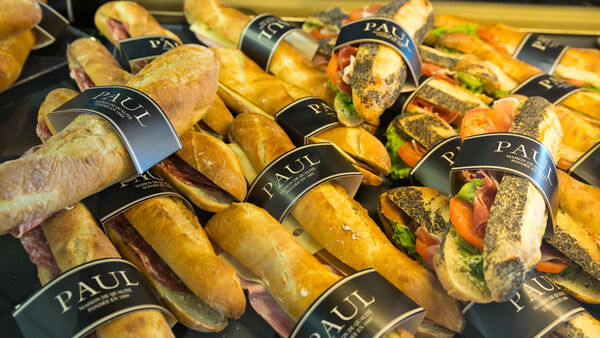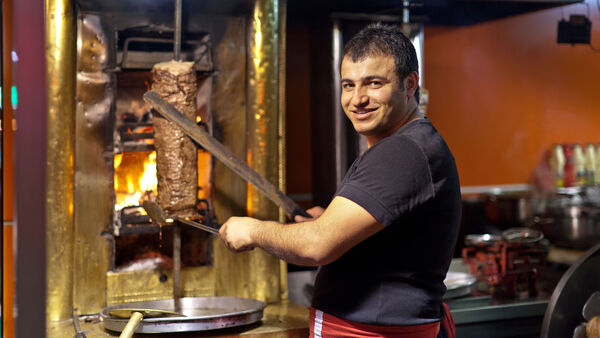Europe’s Cheap Eats


By Rick Steves
Europe offers a bounty of options for eating quickly and inexpensively. Besides picniking — your cheapest option, and my personal favorite — most towns and cities offer a range of basic eateries. While cafeterias, street stands, chain restaurants, and "to-go" meals are not high cuisine, they're cheap. And sometimes what you get is just as tasty as fine restaurant food. Some of my favorite and most memorable meals have been consumed at a market hall or a street-corner sausage stand. For an affordable, quality lunch, line up with the local office workers: They dine out every day and know where the good values are.
Cafeterias and Institution-Affiliated Eateries
"Self-service" is an international word. You'll find self-service restaurants in big cities everywhere, offering low-price, low-risk, low-stress, what-you-see-is-what-you-get meals. All over Europe, towering department stores offer great cafeteria lunches — often with rooftop views for no extra charge (such as at the Galeria Kaufhof in Frankfurt). These places are designed for the shopper who has a sharp eye for a good value. At a salad bar, grab the small (cheap) plate and stack it like the locals do — high. Hungry sightseers also appreciate the handy, moderately priced cafeterias they'll find in larger museums.
If your wallet is as empty as your stomach, find a cheap, humble cafeteria that's associated with (and subsidized by) a local institution — such as a university, church, hospital, charity, senior center, fire station, union of gondoliers, retired fishermen's club, and so on. Profits take a back seat to providing good food at a good price — and many of these eateries welcome the public to pull up a chair. Options range from a cafeteria in Vienna serving Austria's Supreme Court of Justice, to student canteens in university towns (such as Salzburg, Austria), to Poland's dreary-looking but cheap-and-tasty "milk bars." Don't be afraid to take advantage of these opportunities to fill yourself with a plate of dull but nourishing food for an unbeatable price in the company of locals. University cafeterias (generally closed during summer holidays) also offer a surefire way to meet educated, English-speaking young people with open and stimulating minds. They're often eager to share their views on politics and economics, as well as their English, with a foreign friend.
Bakeries and Sandwich Shops
Bakeries are a good place to pick up basic sandwiches, tiny pizzas, or something equally cheap and fast but with more of a regional flavor (such as savory pasties in England or a croque monsieur sandwich in France). The best (and often cheapest) lunch option in Iceland is a bakery's all-you-can-eat soup buffet, which usually includes unlimited fresh-baked bread. Britain's Pret A Manger, Norway's Deli de Luca, and Spain's Pans & Company are chains that sell good, healthful sandwiches, salads, and pastries. Local deli-like shops are popular in many parts of Europe; try a traiteur in France or a rosticceria in Italy.
Street Food and International Eats
Every country has its own equivalent of the hot-dog stand or burger joint, where you can grab a filling bite on the go for cheap — French crêperies, Greek souvlaki stands, Danish pølse (sausage) vendors, Italian pizza rustica takeout shops, German sausage stands, British chippies (fish-and-chips), and Dutch herring carts.
Often the cheapest hot meals in town feature cuisine from another country. International eateries are more common in northern Europe than in southern countries like Italy or Spain. Throughout wealthy northern Europe, immigrant communities labor at subsistence wages. These people have very tasty food traditions, they have very small budgets, and they like to go out and eat. Rather than eat bland and pricey local food, they (along with savvy residents and travelers) go cheap and spicy at simple diners, delis, and takeaway stands serving Middle Eastern and Asian food.
Immigrant restaurants are a godsend for tourists, especially in pricey locales like Scandinavia or Great Britain. In fact, Indian food is considered "going local" in cosmopolitan, multiethnic Britain. You'll find Indian restaurants in most British cities and even in small towns. Take the opportunity to sample food from Britain's former colony.
Of all the international options in Europe, the ubiquitous kebab stand is my favorite. Kiosks selling Turkish-style döner kebab (rotisserie meat wrapped in pita bread), falafel (fried chickpea patties), and other Middle Eastern dishes are popular in many places, including Germany, Florence, and Paris. The best stands have a busy energy, and a single large kebab draped in wonderful pita bread can feed two hungry travelers for €5. Don't miss the ayran — a healthy yogurt drink popular with Turks — which goes well with your kebab.
Market Halls
Europe's old Industrial Age glass-and-steel farmers markets are celebrating their hundredth birthdays by getting a new lease on life as trendy food halls. These market halls still come with the farmers market dimension, but they've been spiced up with great eateries, priced for local shoppers and serving the freshest ingredients. At any stall where you see locals lining up, you know something exciting is being served.
Frankfurt's Kleinmarkthalle, a delightful, old-school market that was saved from developers by local outcry, is now an adventure in fine eating. Torvehallerne, an upscale Copenhagen food court housed in a pair of modern, glassy buildings, is a great place to try smørrebrød (open-face sandwiches topped with delicious fish, cheese, cold cuts, or interesting spreads). Lisbon's Mercado de Campo de Ourique is an early 20th-century iron-and-glass market that has morphed into a trendy food circus with produce stalls, fishmongers, and bakeries that sell everything from pigs' ears to designer cupcakes.
One of my favorite market halls is Florence's Mercato Centrale. It's long been enjoyable as a thriving local market selling meat, fish, produce, and other staples to a mostly local clientele. The market's upper level hosts a wonderful collection of quality eateries that are as busy as the ground-level produce stalls. The food artisans at work here serve pizza and pasta, but they also dish up regional treats. The food court is a real hit with the neighborhood's office workers during the day and provides a good insight into local eating habits. Take a peek at what's on your neighbor's plate — Florentines eat just about every bit of the cow. Stay away from the trippa and lampredotto sandwiches if you can't stomach stomach meat.
If visiting a market hall, be sure to check the hours. Some are open in the evening, while others are geared toward the working crowd and close early. It's best to go at lunch. These days, in nearly any European city, I find sitting down with local shoppers at the traditional market to be a great way to enjoy lunch and feel the pulse of everyday life.
McEurope
American fast-food restaurants are everywhere. Yes, the hamburgerization of the world is a shame, but face it — the busiest and biggest McDonald's in the world are in places like Tokyo and Rome. The burger has become a global thing. You'll find Big Macs in every language — it isn't exciting (and it costs more than at home), but at least at McDonald's you know exactly what you're getting, and it's fast. A hamburger, fries, and shake can be fun halfway through your trip. You'll also see KFC, Subway, and Starbucks.
American fast-food joints are kid-friendly and satisfy the need for a cheap meal and a tall orange juice. They've grabbed prime bits of real estate in every big European city. Since there's no cover charge, this is an opportunity to savor a low-class paper cup of coffee while enjoying some high-class people-watching (unless you're at Starbucks, where your paper cup will be high class, too). Many offer free Wi-Fi as well.
Each country also has its equivalent of the hamburger stand (I saw a "McCheaper" in Switzerland). Whatever their origin, they're a hit with youths and a handy place for a quick, cheap bite to eat.

